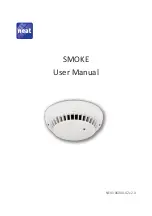
26
Using Biosystems brand calibration gas and
regularly verifying accuracy ensures that proper
sensitivity is maintained for the life of the
sensor.
3.1.1.2.1
Effects of high concentrations of
combustible gas on the combustible sensor
The accuracy of combustible sensors may also be
affected by exposure to high concentrations of
combustible gas. To minimize the chance for
damage or loss of sensitivity to the combustible
sensor, the PhD Ultra is designed to "alarm latch"
whenever the concentration of combustible gas
exceeds 100 percent LEL. Under these conditions
the combustible gas reading will show an “X” to
indicate an over-limit condition. The current gas
reading display will alternate (toggle) with a screen
showing the message “LEL sensor over limit”. The
audible and visual alarms will sound continuously
until the instrument is manually reset by turning it
off, then turning the instrument back on in an area
where the air is known to be fresh.
A combustible sensor over-
range alarm indicates a potentially explosive
atmosphere. Failure to leave the area
immediately may result in serious injury or
death!
In the event of a combustible
sensor over-range alarm, the PhD Ultra must be
turned off, brought to an area that is known to
be safe and then turned on again to reset the
alarm.
Make sure that the PhD Ultra
is located in fresh air before turning the
instrument back on after a combustible sensor
alarm latch condition has occurred. Fresh air
calibration adjustments may only be made when
the PhD Ultra is located in air that is known to
be fresh. After a combustible sensor alarm-latch
condition occurs, the accuracy of the
combustible gas sensor must be verified by
exposure to known percentage LEL test gas
before further use.
Note: The combustible sensor used in the PhD
Ultra requires a minimum of 10% oxygen by
volume in order to generate accurate
combustible gas readings. Combustible sensor
accuracy may be diminished if the instrument is
used in oxygen-deficient atmospheres.
A rapid up-scale reading
followed by a declining or erratic reading may
indicate a hazardous combustible gas
concentration that exceeds the PhD Ultra’s zero
to 100 percent LEL detection range. Failure to
leave the area immediately may result in serious
injury or death!
Avertissement: Toute lecture rapide et positive,
suivie d'une baisse subite au erratique de la
valeur, peut indiquer une concentration de gaz
hors gamme de détection qui peut être
dangereuse.
3.1.1.3 Effects of contaminants on toxic gas
sensors
Biosystems “substance-specific” electrochemical
“smart sensors” used to measure toxic gases have
been carefully designed to minimize the effects of
common interfering gases. “Substance-specific”
sensors are designed to respond only to the gases
that they are supposed to measure. The higher the
specificity of the sensor the less likely the sensor will
be affected by exposure to other gases which may
be incidentally present in the environment. For
instance, a “substance-specific” carbon monoxide
sensor is deliberately designed not to respond to
other gases that may be present at the same time,
such as hydrogen sulfide and methane.
Although great care has been taken to reduce cross-
sensitivity, some interfering gases may still have an
effect on toxic sensor readings. In some cases the
interfering effect may be positive and result in
readings that are higher than actual. In other cases
the interference may be negative and produce
readings that are lower than actual.
Cross sensitivity of PhD Ultra toxic sensors to
common interfering gases is listed in Appendix
E.
3.1.2 Biosystems “CO Plus” dual purpose
carbon monoxide / hydrogen sulfide
sensor
Carbon monoxide and hydrogen sulfide are the two
most common toxic gases associated with confined
space entry. In addition to “substance specific”
sensors designed to measure these toxic hazards,
Biosystems also offers a dual-purpose sensor
designed to detect both carbon monoxide and
hydrogen sulfide. The “CO Plus” sensor is ideal for
situations requiring use of a single sensor to monitor
simultaneously for both toxic hazards.
The “CO Plus” sensor is ideal for situations requiring
the use of a single sensor to monitor simultaneously
for both CO and H
2
S, in which the user does not
need to definitively know which hazard is being
encountered. While the “CO Plus” sensor will
simultaneously detect both carbon monoxide and
hydrogen sulfide, it is only possible to directly
monitor for one of these hazards.
Note: When a specific contaminant such as
hydrogen sulfide is known to be potentially
present, the best approach is usually to use a
direct reading substance specific sensor. The
OSHA standard for permit required confined
















































